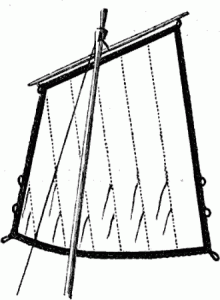From The Elements and Practice of Rigging and Seamanship by David Steel, London: 1794, pp. 109-110.
This sail is quadrilateral, and made of canvas No. 7 or 8. The head is bent to the yard, which hangs obliquely to the mast at one-third of its length, and extends within 4 inches of the cleats.
The fore-leech is as deep as the length of the head, and the after-leech is longer than the fore-leech by nearly half the depth of the fore-leech.
Gores. Two or three cloths are gored on the fore-leech, and an even gore of 6 inches per cloth is made on the head. The foot is gored with a sweep; the cloth at the clue being cut with a three-inch short gore, the next cloth is square, and the cloths from thence to the tack are gored at the rate of six or eight inches per cloth.
Two small holes are made in each cloth in the head.
This sail has two reefs parallel with the foot; the upper one is half-way up the fore-leech, and the other is equally distant from that and the foot. Sometimes reef-bands, three or four inches broad, are put on at the reefs, but when these are not used, a small hole is made in every seam instead of them.
Reef-hanks are used instead of reef points; for which see page 27.
Small cringles are made on the leeches at each reef; earing-cringles are made at the nock and peek; and 10 or 12 strands in the length of the rope are seized at the tack and clue.
To find the quantity of canvas, refer to Rule IX. page 37.

Leave a Reply